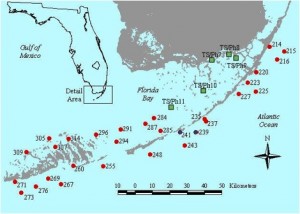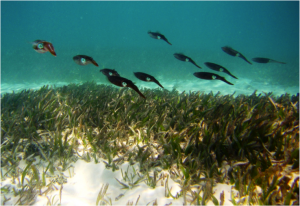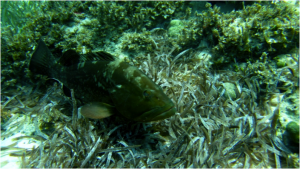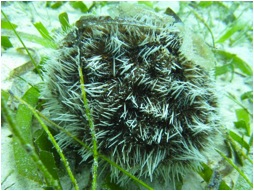22nd May is International Day for Biodiversity and the theme for 2012 is Marine Biodiversity. In celebration, we will be featuring a series of articles on seagrass. This week, Elizabeth “Z” Lacey writes about her experiences in the long-term monitoring project in the seagrass beds of South Florida under the direction of Dr. Jim Fourqurean.
—————————————
By Elizabeth “Z” Lacey
During my own Ph.D. research for the past five years, I have been doing long-term monitoring of the over 18,000 km2 of seagrass beds in south Florida as part of the ongoing research in the Fourqurean Seagrass Ecosystems Research Lab (http://www2.fiu.edu/~seagrass/). Seagrass species present include: Manatee grass Syringodium filiforme, Turtle grassThalassia testudinum, Shoal grass Halodule wrightii, Widgeon grass Ruppia maritima, Johnson’s seagrass Halophila johnsonii, Paddle grass H. decipiens and Star grass H. englemanni. This is a similar list to the one Brooke Landry reported during her vacation in the Bahamas in a previous blog post. Compared to the 50-60 seagrass species possible, our diversity is relatively low. With long-term data on seagrass density and nutrient content, Dr. Jim Fourqurean and fellow researchers are able to determine how these seagrass beds are changing over time and what these changes may indicate for overall seagrass bed health.
 FKNMS permanent seagrass monitoring sites (sites located in the Dry Tortugas are not shown).
FKNMS permanent seagrass monitoring sites (sites located in the Dry Tortugas are not shown).
 Long-term monitoring site Photo by N. Blinick.
Long-term monitoring site Photo by N. Blinick.
 My dive buddy Kirk Gastrich and I complete a seagrass survey at one of the long-term monitoring sites. Photo by N. Blinick.
My dive buddy Kirk Gastrich and I complete a seagrass survey at one of the long-term monitoring sites. Photo by N. Blinick.
Changes in seagrass beds will also have important impacts to the diversity of species that use them for habitat, feeding grounds, refuge and as an important corridor between mangrove and coral reef habitats. While our seagrass diversity may be limited, there are a multitude of important fish, crustacean and other species supported within these ecosystems. It is estimated that Florida seagrass beds provide ecological services worth over $40 billion US each year (http://www.dep.state.fl.us/coastal/news/articles/2011/1103_Seagrass.htm). In addition to the photos of stingrays and sea turtles I posted in my other World Seagrass Association blog entry about my work in Akumal, Mexico, there are a wide diversity of animals that can be seen on any given dive in the seagrass beds of South Florida. But rather than bore you with my prose, why don’t I let the pictures speak 1,000 words (or many thousands when it comes to the number of diverse species supported in tropical seagrass beds!).
 Caribbean Reef Squid (Sepioteuthis sepioidea). Photo by Captain K. Gastrich.
Caribbean Reef Squid (Sepioteuthis sepioidea). Photo by Captain K. Gastrich.
 Barracuda (Sphyraena barracuda) Photo by Z. Lacey
Barracuda (Sphyraena barracuda) Photo by Z. Lacey
 Grouper, an important commercial species, spotted in the seagrass bed. Photo by J. Sweatman
Grouper, an important commercial species, spotted in the seagrass bed. Photo by J. Sweatman
 Sea urchin using turtle and manatee grass to camouflage itself in the seagrass bed. Photo by Z. Lacey
Sea urchin using turtle and manatee grass to camouflage itself in the seagrass bed. Photo by Z. Lacey
 Octopus inside a pipe positioned in the seagrass bed to hold a channel marker—you never know what you’ll find when you are observant while snorkeling in a seagrass bed! Photo by Z. Lacey
Octopus inside a pipe positioned in the seagrass bed to hold a channel marker—you never know what you’ll find when you are observant while snorkeling in a seagrass bed! Photo by Z. Lacey
These photos are just a few of the many, MANY species that can be found in Florida seagrass beds. On a recent field trip with my Introduction to Marine Biology students at Florida International University, we caught other animals like moray eels, batfish and sea robins! In honor of today being International Day for Biodiversity, I invite you to get into the water and spend some time in the seagrass beds. If you aren’t lucky enough to live near some of these magical ecosystems, then on next vacation you have I invite you to head on down to the Florida Keys and enjoy the diversity of life that seagrass beds support. These are the things that keep me excited about working in marine ecosystems as I prepare to defend my Ph.D. in just a few short weeks!